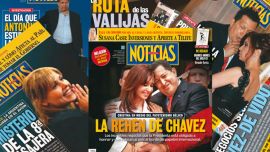What better time to write about the International Atomic Energy Agency (IAEA) than with brinkmanship over the nuclear agreement with Iran on the front-burner at this week’s United Nations General Assembly, while the IAEA is due to start electing its new chief as from next Thursday with an Argentine, diplomat Rafael Mariano Grossi, as a top candidate for the post?
If not the top candidate. Among his rivals, Romanian Cornel Feruta (the stopgap replacement as acting director general for Japan’s Yukiya Amano, who succumbed to cancer just two months ago) has little more in his favour than occupancy, although that advantage should never be underestimated, while the other two candidates – Burkina Faso’s Lassina Zerbo and Slovakia’s Marta Ziakova – are latecomers to the race. Indeed, Grossi might well have become IAEA chief a couple of years ago if the UN Secretary-General ambitions of then-foreign minister Susana Malcorra had not obliged him to hold back (two Argentines in top international posts were assumed to be too much).
The vastly experienced Grossi, 58, Argentina’s ambassador to the IAEA who has held senior disarmament posts since 1997, is backed by the Americas from top to bottom with Donald Trump’s Energy Secretary Rick Perry opining: “Sounds like a perfect candidate to me.” Respected by China, he also enjoys support from the Commonwealth countries and even some Europeans, despite having two rivals from that continent. Quite apart from his solid credentials, it is high time that somebody from the southern half of the world headed the IAEA.
But if Grossi is enshrined, he could face more potential tightropes than local presidential frontrunner Alberto Fernández. Above all, where Iran is concerned with growing international tension since Trump pulled out of the 2015 international agreement with Iran last year. Somehow, if chosen for the post, Grossi has to defend geopolitical peace against Trump while knowing full well that Washington’s claims as to Tehran crossing the line are far from unfounded (from personal experience as Amano’s choice to spearhead the 2011 Iran investigation, while his own IAEA inspectors recently ascertained that Tehran has surpassed the limits on its enriched-uranium stockpile).
Grossi’s formula for squaring this circle thus far is to defend the agreement as “still in force” while pledging to try and salvage it (Feruta also strongly advocates the deal) but also calling for tighter tabs on Iran from safeguards inspectors with “firm but fair monitoring.” In the process he needs to stay in Perry’s good books despite Argentina’s track record of supplying Iran’s research reactor with fuel and training Iranian scientists (even if all for strictly civilian purposes), as well as approaching China and Russia – but nor does he want to offend the latter by steering too close to Washington, which could backfire.
Such dilemmas have plagued the agency throughout this century – the fear of IAEA reports being used to justify renewing conflict in the Middle East versus the hard evidence against Iran (the target of UN Security Council sanctions from 2005 until the 2015 agreement). This dilemma led the IAEA to give that agreement the benefit of the doubt.
But Grossi also has an agenda beyond Iran (or a currently dormant North Korea where the Argentine candidate seeks a denuclearisation agreement before the next scare). He would like to take the IAEA into a new dimension by expanding its limited base via public-private partnerships and teamwork with NGOs (non-governmental organisations) as well as pooling resources with other UN organisations in order to have a “bigger voice” in more debates, including sustainable development and climate change. But for this extended outreach he would first need to surmount UN and agency rules against accepting funds from industry or NGOs.
* * *
The IAEA defines its three main missions as promoting the peaceful use of nuclear energy, implementing safeguards against its military use and (especially in the last three decades) safety checks on reactors worldwide. The IAEA’s top priority between these three missions has tended to oscillate over the years, depending on where the most immediate threat to humanity is perceived.
The agency was a child of the Cold War – born in the summer of 1957 shortly after the Hungarian Revolution and the Suez Canal crisis when nuclear warheads were being multiplied at terrifying speed, United States President Dwight Eisenhower considered it necessary also to promote the peaceful use of atomic energy (the subject of his “Atoms for Peace” address to the 1953 UN General Assembly at the start of his administration). As a US initiative, Eisenhower could impose a fellow-Republican as the first Director General – William Sterling Cole (1957-1961) – but thereafter the IAEA helm was the domain of neutral Sweden for almost the rest of the century. The nuclear physicist Sigvard Eklund headed the agency for fully two decades (1961-1981), followed by the former foreign minister Hans Blix (1981-1997), later to become more famous when heading the 2002 UN commission probing “weapons of mass destruction” in Iraq.
The highlight of the IAEA’s history thus far was the award of the 2005 Nobel Peace Prize – received by Egypt’s Mohamed ElBaradei (director general from 1997 to 2009) although the prize was basically a tribute to the post-IAEA career of Blix in debunking the “weapons of mass destruction” and at least partly due to work preceding ElBaradei’s term, namely the intensified propagation of nuclear safety in the wake of the Chernobyl reactor disaster in 1986. ElBaradei made a ringing acceptance speech with the IAEA’s core message against nuclear weapons, pointing out that only one percent of this spending would suffice to feed the world. Little did Amano suspect when he assumed the IAEA helm in 2009 that his own country would be in line for the next major nuclear disaster – Fukushima in March, 2011.
The IAEA has an anomalous relationship with the UN – autonomous but reporting to both the Security Council and the General Assembly, working closely with the former. The bureaucratic structure is minimal with its Vienna headquarters only established in 1979 – a Board of Governors meeting five times annually and a General Conference of all members meeting once (usually in September) apart from the core organ of the Secretariat with its 2,500-strong professional staff.
But some critics say that this structure leads to the opposite of agility since it limits its mandate and makes it vulnerable to constraints imposed by member states. Even if only around 60 countries factor nuclear power into their energy grids, the IAEA houses 171 of the 193 UN members – with the single exception of North Korea (which left in 1994), all countries outside the IAEA are too tiny and/or poor to be seriously relevant.
Argentina’s nuclear history predates the IAEA – going all the way back to a false start in 1948 with the Huemul Project for nuclear fission under the refugee Nazi physicist Ronald Richter but later acquiring more substance in the same Bariloche area with the prestigious INVAP (founded in 1976 under the forceful leadership of Vice-Admiral Carlos Castro Madero), a state-run agency whose 1,400 employees have generated orders worth almost US$1 billion (including the construction and design of the reactor in Lucas Heights, Australia, completed in 2007). Ever since Richter, military dictatorships and elected governments of all parties alike, amid boom-and-bust economic cycles, have tended to staff the CNEA National Atomic Energy Commission (founded in 1950) with apolitical professionals, starting with José Antonio Balseiro. Will a new era dawn for the IAEA as from next Thursday?





















Comments